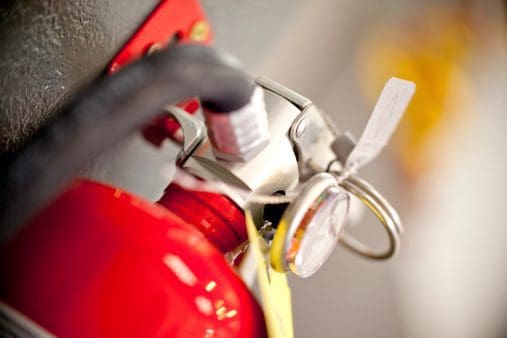My HSE career has consisted of more inspections and audits than anything else. When I approach a worksite, one of the first things I scan for and inspect is the presence of fire extinguishers. In the beginning, I would prematurely find comfort in seeing they were staged in the work area, even if not placed in the ideal locations.
With time comes seasoning. As my career developed, I realized that although fire extinguishers were in plain sight, they were not necessarily in proper working order. Most of them were not fully charged, out of date on the inspection, and found to be damaged. Sometimes the unit found on location was not designed to combat the exact source of the fire. These results reflected the ugly truth that should an incipient fire initiate, it was inevitable that it would grow to an uncontrollable stage and could result in death and property damage, all because the present fire extinguishers did not yield the capability to defeat that initial fire. Instead of being a lifesaving tool, they serve as nothing more than a glorified conversation piece or prop.
Incorrect Use
Fire extinguishers are matched explicitly to certain types of fires. Their use is indicated by a lettering system and should be used following the terms specified:
- Class A: Ordinary combustibles including wood, paper, cloth, trash, and plastics.
- Class B: Flammable liquids and gases that include gasoline, oil, grease, acetone, and propane.
- Class C: Electrical, which includes equipment that is plugged into a power source.
- Class D: Combustible metals that include magnesium, titanium, zirconium, sodium, lithium, and potassium.
- Class K: Cooking fires that contain grease, fats, and oils.
Employees should be trained to recognize the correct fire extinguisher needed for the type of work being conducted. Work taking place on an upstream oil and gas location is more likely to find protection with an A or B fire extinguisher than a K.
Charging
Fire extinguishers must be charged to function adequately to perform as intended. Each fire extinguisher contains a gauge that depicts its charged condition, and the needle positioned in the green indicates it is correctly charged and ready to be used.
Should the gauge needle be found in the red area, it should immediately be removed from service. It is either needing a recharge, or it can be overcharged. Neither scenario is ideal and must be rectified. Another situation can be experienced in this area of fire extinguisher safety. If the dial or gauge is not visible, the user should exercise caution and remove it from service. If one cannot determine the charged condition, then they have no alternative but to assume it is defective. In this case, it should be replaced immediately in the field.
Component Damage
One of the most common examples of fire extinguisher damage is a rusted base, and a compromised bottom can lead to unsuspected discharge and leaking. If this issue goes unnoticed, the fire extinguisher may very well be useless when accessed for use in a life-threatening situation.
Care and concern should be given to the discharge hoses found on fire extinguishers. Cracks and splits can reveal a loss of pressure, and even in an uncontrolled fashion. They can become faulty and once again leave the unit unavailable for proper use. Imagine the frustration should a fire extinguisher be needed but is damaged and inoperable. The wait for the fire brigade is going to seem long, and the consequences will be significant.
Tag Inspections
Two different tag inspections initially enable successful fire extinguisher use. Each of these inspections requires the reflection to be designated on the unit, and a tag suffices.
Monthly inspections include a variety of factors. If inspections are strategically staged around a facility, the monthly review includes noting their visibility and accessibility. They serve no purpose if they cannot be found or accessed. Additionally, the body of the fire extinguisher should be inspected for rust and corrosion. They should also be searched for possible leaks and to verify the nozzle is fully functional. Monthly inspections can be conducted by a competent individual who will affix a tag to the unit’s neck, indicating successful completion of the assessment itself.
A third-party source must provide annual inspections. The criteria include the monthly visual inspection, but additional and crucial steps are taken. They must be put through a hydrostatic test where it is stripped of many components and left as shell and hose. It is filled with water where a certain pressure must be retained for a specific interval of time. The unit is then thoroughly dried, put back together, and then recertified for use. An annual inspection tag is placed on the fire extinguisher and is then ready for re-entry into the field. Any fire extinguisher that fails a hydrostatic test must be retired from service.
Proactive Care
Fire extinguishers should be considered as valuable as any other tool is used to complete a task. Exercising responsible care through inspections and proper storage, amongst other actions, can ensure a long and prosperous life.
Taking the time to ensure proper care enables the complete function in the event of an emergency. Caring for units and conducting inspections can make the difference in watching an uncontrollable fire rage that costs life instead of watching a fire brigade ensure a fire is completely extinguished after being attacked by a portable extinguisher.
Nick Vaccaro is a freelance writer and photographer. In addition to providing technical writing services, he is an HSE consultant in the oil and gas industry with twelve years of experience. Vaccaro also contributes to SHALE Oil and Gas Business Magazine, American Oil and Gas Investor, Oil and Gas Investor, Energies Magazine and Louisiana Sportsman Magazine. He has a BA in photojournalism from Loyola University and resides in the New Orleans area. Vaccaro can be reached at 985-966-0957 or nav@vaccarogroupllc.com.







